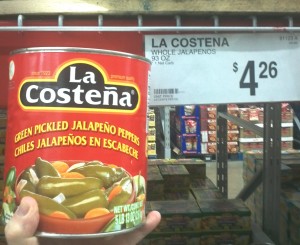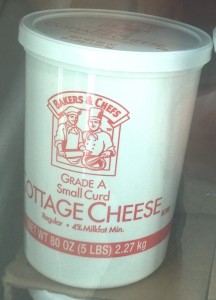When we last talked, I promised you that I would tell you how and why it is ever okay to buy more than you need, and (gasp) even throw food away in certain circumstances.
First, I’d like to emphasize that I really am not in favor of waste. I believe that we should do our best to buy what we need and use up what we buy. And of course, it’s good to plan ahead so that you will have a use for (especially) ALL the food you buy, and I encourage you to do that.
But when you think about it, we are in a war: a war to make the best use we possibly can of our limited resources. Most of the time, unless your last name is Rockefeller or Gates, one of those scarce resources is money, and it’s my intention to help you keep as much of it as you can where it belongs: in your pocket.
There are only two people in my household: my husband and I. We can only eat so much. We can only use so many cleaners, so many paper towels, so much laundry detergent. But we maintain a membership at Sam’s and at Costco, and I believe that even with only two people, it’s a good thing to do.
One of the things that you hear often, when listening to people who talk about money, budgeting and finances, is that you shouldn’t buy more than you can use because it will go to waste. Well, maybe it will (though I still believe that with proper planning, you don’t have to throw food away much at all – we never do). But think about it: which would you rather waste, a little bit of food, or your money?
I contend that you will be better off in the long run wasting a little bit of food instead of a good bit of money, if that’s the choice you have! And in many cases, it might be the best choice you have!
Hubby and I went to Sam’s recently to buy some of our regular groceries. We put a few things in our cart that we had already planned to buy and I took the opportunity to do some comparison shopping between Sam’s and Walmart. I found some pretty interesting things!
We tend to buy foods that I call “real” foods. They are foods that are processed as little as possible, and close to how they came from nature. For example, obviously, there is some processing involved with milk in order to make sour cream, cream cheese, and cottage cheese, but we buy them not already made into another product, like lasagna, or fettuccine Alfredo. I make my own lasagna, my own Alfredo sauce, and I make my fettuccine out of zucchini (we don’t eat wheat, so there are a lot of substitutions, but that’s another story!)
So when we went to Sam’s, I made a point to comparison shop with foods that we normally buy. For example, I looked at:
Sour cream
Cream cheese
Cottage cheese (Can you tell we like dairy products?)
Jalapeno slices
Pace Salsa (Oops! A manufactured food!
Green Beans
Catsup (Another manufactured food, but I put it for convenience only, since I make my own catsup.)
Whole Peeled Tomatoes
Tomato Sauce
I discovered that when comparing between the two stores, if you plan to eat enough of the item, then you can eat that much for the same price as you would have paid for the same item at Sam’s, and any additional amount of the item you purchased at Sam’s – is free! Since it’s free, you can do any number of things with it, including adding it to recipes for the week, splitting it with friends and neighbors, or, if you really can’t think of anything else to do with it, you could throw it away, but I don’t recommend that at all.
I realize that it all sounds a bit confusing. If you think YOU are confused, you should have seen me trying to figure out how to explain this! So, let’s take the first example: sour cream. The largest container of sour cream at Sam’s is 80 ounces  and costs $5.88. The largest container I found of sour cream at Walmart was 24 ounces and cost $2.68. The Sam’s sour cream cost 0.0735 per ounce and the Walmart sour cream cost .1117 per ounce. So we can already see that it’s less expensive to buy our sour cream at Sam’s, but that’s pretty much what you expected, anyway, right?
and costs $5.88. The largest container I found of sour cream at Walmart was 24 ounces and cost $2.68. The Sam’s sour cream cost 0.0735 per ounce and the Walmart sour cream cost .1117 per ounce. So we can already see that it’s less expensive to buy our sour cream at Sam’s, but that’s pretty much what you expected, anyway, right?
The big question is: will you eat enough sour cream before it goes bad to justify buying the larger container? Well, let’s see (and I hope you like dip!) The $5.88 you spend at Sam’s buys 80 ounces, as we said, but this same amount of money will only buy 53 ounces of sour cream at Walmart. So, if you choose the Sam’s container, then every bite of sour cream you eat more than 53 ounces is “free,” Even if you have to throw away up to 26 ounces of sour cream from the Sam’s container, you still came out ahead, as long as you buy it at Sam’s AND as long as you use at least 53 ounces of sour cream. <=Click to Tweet
The next item I chose was Pace Medium Salsa. There were several types to choose from but I will demonstrate the difference between the warehouse store price and the lowest-price per ounce option at Walmart. The largest, and of course, least cost per ounce, was the 138-ounce container at Sam’s. At $8.78, the price was only .0636 per ounce. For the offerings from Walmart, the same-brand least expensive Salsa was 64 ounces at $5.65 (.0883 per ounce). Now keep in mind that this is the same brand and variety (medium) salsa; the only difference is the size of the containers. So, if you choose at Sam’s to purchase the 138-ounce container, you would need to eat 100 ounces of the salsa in order to get the rest of the salsa for “free” (hey, that’s MORE than a quart) compared to what you would pay at Walmart. Hey, I have an idea: mix the free sour cream with the free salsa and have a party! For FREE!
Here are a few other options I figured out for you. I won’t go through the individual calculations; it’s always the same, just like the above descriptions, but for reference, I used the least-expensive choice at Sam’s compared with the least-expensive alternative at Walmart. If you were to try these comparisons against products at other grocery stores, you would have even a larger amount of “free” product when you buy at Sam’s, as long as the items are more expensive than they are at Walmart (and most groceries are, indeed, more costly at other grocery stores).
|
Item |
Sam’s Size |
Sam’s Price/Oz. |
Walmart Size |
Walmart Price/Oz. |
How much of Sam’s item to eat – and then the rest is free! |
Free Amount for this Item |
| Philadelphia Cream Cheese | 48 oz. | .1350 | 8 oz. | .2475 | 27 oz. | 21 oz. |
| B & C Cottage Cheese | 80 oz. | .0873 (Kraft Simply) | 24 oz. | .1100 | 63 oz. | 16 oz. |
| La Costena Jalapeno Slices | 93 oz.(#10 can) | .0458 | 12 oz.(Old El Paso) | .2067 | 21 oz. | 72 oz. |
| Del Monte Cut Green Beans | 101 oz. (#10 can) | .0315 | 14 oz. | .0345 | 93 oz. | 8 oz. |
| Hunt’s Catsup | 114 oz. (#10 can) | .0288 | 35 oz. | .0476 | 69 oz. | 45 oz. |
| B & C Tomato Sauce | 102 oz. (#10 can) | .0262 | 8 oz. (Great Value) | .0413 | 68 oz. | 34 oz. |
| B & C Whole Tomatoes | 102 oz. (# 10 can) | .0273 | 14.5 oz. | .0386 | 73 oz. | 28 oz. |
| Sour Cream | 80 oz. | .0735 | 24 oz. | .1117 | 53 oz. | 27 oz. |
| Pace Medium Salsa | 138 oz. | .0636 | 64 oz. | .0883 | 100 oz. | 38 oz. |
If you are creative, you will soon discover that it’s not necessary (and certainly not desirable) to throw away the food you have received for free. Why don’t you do some advance menu planning and find good ways to use this extra food you got? Tomato sauce is one of my favorites: if I can’t figure out a way to use it within a short time, I just put it in a small plastic container and freeze it! Then, it’s ready any time! Catsup essentially lasts “forever,” so having extra of it is no problem, and as long as you plan to use the tomatoes in soups and stews, they can be frozen as well. I have known cream cheese to last months, unless I was making a cheesecake. Green beans might be a little more problematic, because you have to consume 93 ounces before you start pulling ahead, and if there was one item on this list that I consider least worth it, it would be the green beans. As you can see by the chart, you only get 8 ounces for free, anyway.
I hope you will take this idea and run with it. Figure out which foods you can get “free” if you carefully check your prices, and see which ones work best for you.
To Recap:
- Almost all foods are less expensive when purchased in bulk (but check to make sure)
- Figure up how much of the less expensive food you would have to eat to equal the cost of the more expensive food; what’s left is your “free” component
- Plan ahead for how to use up your “free” foods so you won’t end up throwing them away
Enjoy your savings!








